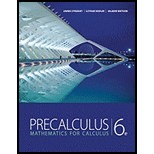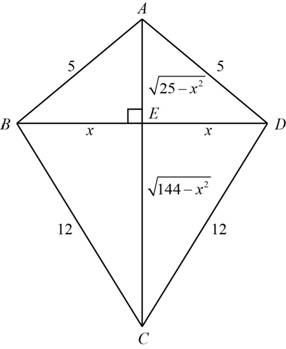
Concept explainers
Area of a Kite A kite frame is to be made from six pieces of wood. The four pieces that form its border have been cut to the lengths indicated in the figure. Let x be as shown in the figure
- (a) Show that the area of the kite is given by the function
- (b) How long should each of the two crosspieces be to maximize the area of the kite?
(a)
To show: The area function of the kite is
Explanation of Solution
The kite contains four triangles with finite lengths is shown below,

Figure (1)
In
Use the Pythagoras theorem to find the length AE,
In
Use the Pythagoras theorem to find the length CE,
The formula to calculate the area of triangle is,
The formula to calculate area of kite,
Thus, the area function of the kite is
(b)
To find: The length of the cross pieces of the kite to maximize the area of the kite.
Answer to Problem 32P
The length of the two cross pieces are
Explanation of Solution
Given:
The given kite frame to be made from six pieces of wood is shown below,

Figure (1)
From the part (a), the area function is
To find the lengths of the cross pieces of the kite which maximize the area of the kite, it needs to draw the graph of the function
The function contains the variable x is length of the horizontal cross piece.
The local maximum value of the function is the maximum finite value where the value of the function at the any number is greater than to the original function.
The condition for local minimum is,
The graph of the function is shown below.

Figure (2)
From the graph of the function shown as Figure (2) the greatest peak of the graph at the point
Then, the maximum area of the kite is
The length of the side BD in the figure (1) is,
Substitute 4.979 for x in the value of
The length of the side AC in the figure (1) is
Now, substitute 4.979 for x in the length of the side AC.
So, the original value of x is
Thus, the value of one cross piece is
Chapter 2 Solutions
EBK PRECALCULUS: MATHEMATICS FOR CALCUL
- 2. Suppose the population of Wakanda t years after 2000 is given by the equation f(t) = 45000(1.006). If this trend continues, in what year will the population reach 50,000 people? Show all your work, round your answer to two decimal places, and include units. (4 points)arrow_forward3. Solve the equation, give the answer exactly (no calculator approximations), and show all your work. (4 points) log5 2x = 3arrow_forwardLet I = f(x) dx, where f is the function whose graph is shown. 4 2 y f X 1 2 3 4 (a) Use the graph to find L2, R2 and M2. R₂ M2 = = = (b) Are these underestimates or overestimates of I? O 42 is an underestimate. O 42 is an overestimate. ◇ R2 is an underestimate. OR2 is an overestimate. OM2 is an underestimate. ○ M2 is an overestimate. (c) Use the graph to find T2. T₂ =arrow_forward
- Vector u has a magnitude of 23 and vector v has a magnitude of 83. The angle between the two vectors is 126 degrees.a) Draw a fully-labelled vector diagram showing the two vectors and the resultant vector when they are added together.b) Find the magnitude of the resultant vector.c) Find the direction of the resultant vector relative to vector u. Solding by finding the x and y of the vectors and addingarrow_forwardFind the range and all the answers. Remark that the range isn’t between -(pi/2) and (pi/2)arrow_forwardPlease draw a detailed grapharrow_forward
- For allarrow_forward3) If a is a positive number, what is the value of the following double integral? 2a Love Lv 2ay-y² .x2 + y2 dadyarrow_forward16. Solve each of the following equations for x. (a) 42x+1 = 64 (b) 27-3815 (c) 92. 27² = 3-1 (d) log x + log(x - 21) = 2 (e) 3 = 14 (f) 2x+1 = 51-2xarrow_forward
- 11. Find the composition fog and gof for the following functions. 2 (a) f(x) = 2x+5, g(x) = x² 2 (b) f(x) = x²+x, g(x) = √√x 1 (c) f(x) = -1/2) 9 9(x) = х = - Xarrow_forwardpractice problem please help!arrow_forward13. A restaurant will serve a banquet at a cost of $20 per person for the first 50 people and $15 for person for each additional person. (a) Find a function C giving the cost of the banquet depending on the number of people p attending. (b) How many people can attend the banquet for $2000?arrow_forward
 Calculus: Early TranscendentalsCalculusISBN:9781285741550Author:James StewartPublisher:Cengage Learning
Calculus: Early TranscendentalsCalculusISBN:9781285741550Author:James StewartPublisher:Cengage Learning Thomas' Calculus (14th Edition)CalculusISBN:9780134438986Author:Joel R. Hass, Christopher E. Heil, Maurice D. WeirPublisher:PEARSON
Thomas' Calculus (14th Edition)CalculusISBN:9780134438986Author:Joel R. Hass, Christopher E. Heil, Maurice D. WeirPublisher:PEARSON Calculus: Early Transcendentals (3rd Edition)CalculusISBN:9780134763644Author:William L. Briggs, Lyle Cochran, Bernard Gillett, Eric SchulzPublisher:PEARSON
Calculus: Early Transcendentals (3rd Edition)CalculusISBN:9780134763644Author:William L. Briggs, Lyle Cochran, Bernard Gillett, Eric SchulzPublisher:PEARSON Calculus: Early TranscendentalsCalculusISBN:9781319050740Author:Jon Rogawski, Colin Adams, Robert FranzosaPublisher:W. H. Freeman
Calculus: Early TranscendentalsCalculusISBN:9781319050740Author:Jon Rogawski, Colin Adams, Robert FranzosaPublisher:W. H. Freeman
 Calculus: Early Transcendental FunctionsCalculusISBN:9781337552516Author:Ron Larson, Bruce H. EdwardsPublisher:Cengage Learning
Calculus: Early Transcendental FunctionsCalculusISBN:9781337552516Author:Ron Larson, Bruce H. EdwardsPublisher:Cengage Learning





